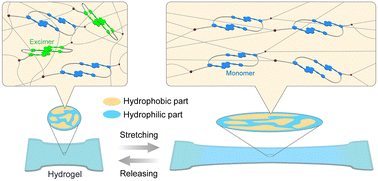Mechanochromic luminescence of phase-separated hydrogels that contain cyclophane mechanophores†
Abstract
Mechanochromic mechanophores that are covalently introduced into polymer materials can visualize the mechanical force applied to the polymer chains. Mechanochromic hydrogels using mechanophores such as 1,2-dioxetane derivatives, spiropyran, and rhodamine have been developed so far. However, these hydrogels do not show instant reversibility in response to force because scission of covalent bonds is needed for the mechanophores for activation. Here, mechanochromic luminescent hydrogels that show reversible changes of emission properties are demonstrated utilizing a cyclophane-based supramolecular mechanophore whose working mechanism does not rely on the breakage of covalent bonds. The cyclophane mechanophore is introduced into phase-separated hydrogels as a crosslinker. The decrease in intramolecular excimers upon deformation results in the mechanochromic luminescence and the emission change was achieved reversibly and instantly. It was also found that most of the mechanophores are incorporated into the hydrophobic part of the hydrogels, when replacing dimethylsulfoxide with water in the gels.



 Please wait while we load your content...
Please wait while we load your content...